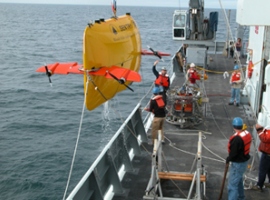Robot Vehicle Surveys Deep Sea Off Pacific Northwest - August 13,2008

The first scientific mission with Sentry, a newly developed robot capable of diving as deep as 5,000 meters (3.1 miles) into the ocean, has been successfully completed by scientists and engineers from the Woods Hole Oceanographic Institution (WHOI) and the University of Washington (UW).The vehicle surveyed and helped pinpoint several proposed deep-water sites for seafloor instruments that will be deployed in the National Science Foundation (NSF)'s planned Ocean Observatories Initiative (OOI).
Sentry, an autonomous undersea vehicle, was used for the first time last month.It is a state-of-the-art, free-swimming underwater robot that can operate independently, without tethers or other connections to a research ship.

The autonomous underwater vehicle, or AUV, is pre-programmed with guidance for deep-water surveying, but it can also make its own decisions about navigation on the terrain of the seafloor. "This investment into emerging technologies is paying off in delivering state-of-the-art science support," said Julie Morris, director of NSF's Division of Ocean Sciences. "In the near future, Sentry will conduct high-resolution oceanographic surveys that would be otherwise impossible.
"We are changing the way ocean science is done, launching a new era in which an ensemble of technologies will provide us with an increasing capacity for exploring and interacting with the global oceans," said John Delaney, chief scientist of the expedition and principal investigator for the UW-led regional observatory in the planned OOI.
"Sentry had a very successful introduction," said Dana Yoerger, the lead WHOI engineer for the vehicle. "We had tested the AUV as best we could before we got out here, but the steep terrain of the deep sea is quite a different matter."
The AUV can collect the data needed to make seafloor maps at a resolution of less than one meter. On this first cruise, Sentry collected as many as 60 million individual soundings of seafloor depth in a single dive.
Sentry is designed to swim like a fish or fly like a helicopter through the water. The sleek hydrodynamic design allows the vehicle to descend quickly from the sea surface to the depths (about 3,500 meters per hour).When necessary, the AUV also can hover over the bottom for close-up inspections, navigational decision-making, and for rising up and down over rugged seafloor terrain.
"Sentry is a true robot, functioning on its own in the deep water," said Rod Catanach, a WHOI engineer who works with Sentry. "The vehicle is completely on its own from the time it is unplugged on the deck and cut loose in the water."
Vehicles like Sentry and its successors will plug into and interact with the ocean observatory system, using the power charging systems and high speed communications delivered by the submarine networks.
 Deep Sea Crabs
Deep Sea Crabs